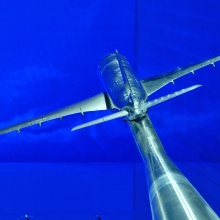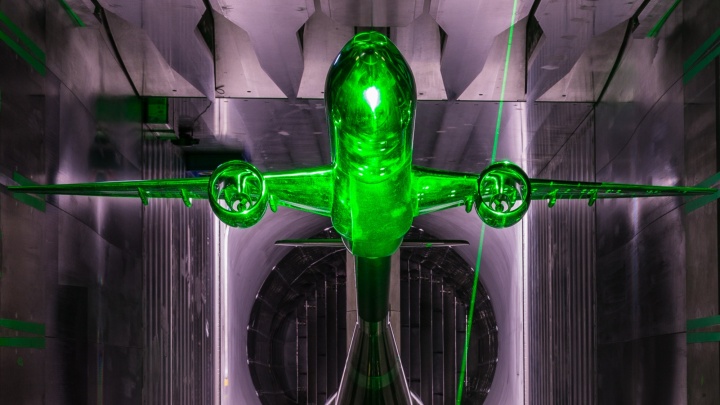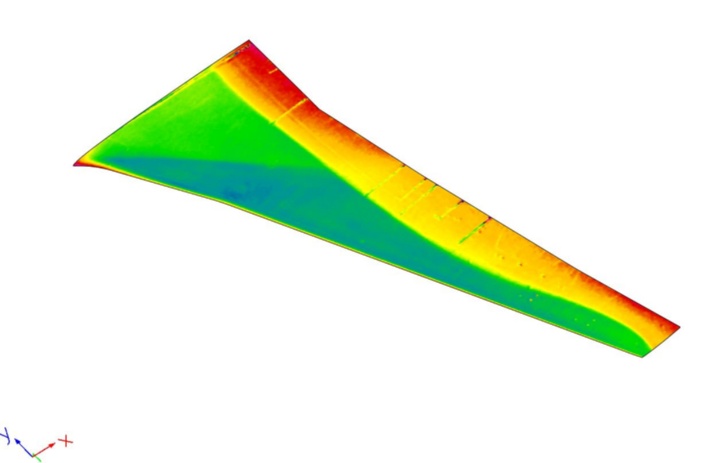In the fight against climate change, the airline industry is working hard to reduce its fossil fuel consumption. In addition to alternative fuel concepts, aircraft manufacturers are looking for ways to increase efficiency. To this end, irrespective of the type of propulsion and already during the development stage, aircraft in future must be better geared to anticipated loads in cruise flight or in extreme situations. This, exactly, is what the DFG Research Group 2895 at the University of Stuttgart wants to achieve: The researchers want to better understand the physical phenomena involved in the flow around an aircraft and were able to present impressive measurement results.
The group named “Unsteady Flow and Interaction Phenomena at High-Speed Stall Conditions” (spokesperson: Dr. Thorsten Lutz, Institute of Aerodynamics and Gas Dynamics, IAG) is working on seven sub-projects and consists of scientists from four German universities as well as the German Aerospace Center (DLR). The sub-projects are funded by the German Research Foundation (DFG). The lead management is in the hands of the University of Stuttgart’s IAG, which is also working on two of the scientific sub-projects. The scientists use wind tunnel data from complex experiments in the European Transonic Wind Tunnel (ETW) in Cologne, in conjunction with state-of-the-art numerical simulation methods, in order to gain insight into the physical processes in the wing wake.
Only so-called cryogenic wind tunnels, which are operated at very cold temperatures and at overpressure, are able to simulate real flight conditions on models. For this purpose, an aircraft model made of special steel and equipped with measurement technology is placed in an environment cooled down to -160 °C. A powerful compressor generates an inflow of up to 800 km/h and reproduces the cruise flight conditions just below the speed of sound. Operating the wind tunnel is expensive and every second counts. To make the most of the allocated time in the wind tunnel, every aspect of such a multi-day measurement campaign is therefore meticulously planned and optimized months in advance. The first series of measurements were conducted in late 2020 and in 2021.
Measurements with high-speed cameras
In the current series of measurements, scientists from the DLR were able to measure the pressure on the entire wing and on the tailplane for the first time. To this end, they coated the surfaces with a pressure-sensitive varnish and used high-speed cameras that take up to 2,000 photos per second. Image processing algorithms that the scientists wrote themselves allow them to convert the images into pressure information. “To the aerodynamics specialists, such high-resolution information is something money can’t buy,” emphasizes Dr. Thorsten Lutz. “You can use it to detect very small fluctuations in pressure conditions on the wing, and we understand at which flight conditions these grow to a size that generates vibrations and unwanted loads in the aircraft.”
However, the flow around an aircraft is significant not only at the surface, but also, for example, at the wing wake, i.e. the turbulent area behind the wing. If the chaotically fluctuating air molecules that occur there hit the tailplane located at the rear, this leads to undesirable vibrations which can have a negative effect on the service life of the parts. However, the movement of the air is not visible to the naked eye. Aircraft designers therefore design the aircraft and its controls in such a way that this interaction is avoided as much as possible.
The researchers used laser technology to visualize and measure what happens when this does occur in an extreme situation. In the so-called PIV (particle image velocimetry) method, tiny ice crystals are placed in the flow, which are illuminated by a laser and photographed with an extremely fast camera. This reveals the movement of the air molecules through the turbulent flow region, and the researchers can obtain information about the resulting forces on the aircraft. “This allows us to look into the flow around a commercial aircraft in a level of detail that we could previously only dream of,” says Lutz. “By analyzing these data, we can understand much better what happens if the aircraft is caught in a strong gust, for example.”
| Contact | Dr. Thorsten Lutz, University of Stuttgart, Institute of Aerodynamics and Gas Dynamics, phone: +49 711 685 63406, email |
|---|
Expert Contact:
Dr. Thorsten Lutz, Universität Stuttgart, Institut für Aerodynamik und Gasdynamik, Tel.: +49 711 685 63406, E-Mail




